With the release today of Hitchhikers Guide to the Galaxy (it releases in the USA on Friday), Jeff Heusser spoke to Adam McInnes. McInnes is one of the VFX supervisors for Cinesite Europe, which did nearly 100% of the digital visual effects in the film.
Hitchhikers was nearly not made and it was not until Douglas Adams’s death that Austin Powers Director Jay Roach became involved. Roach decided against directing the movie himself but instead chose to work with Adam’s long time close friend and the film’s Executive Producer Robbie Stamp. Stamp got the film made via Disney in the USA. The producing team appoached Film Clip director Garth Jennings, of Hammer and Tongs, and the film was green lit for production.
and a Vogon, based on 18th century political cartoons”]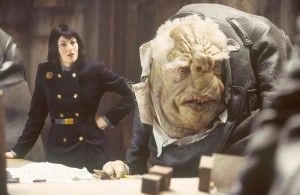
Henson’s Creature shop produced extremely complex live action suits and puppetsthat were able to perform and ‘act’ to camera for all the characters. In the out takes of the film after the takes were completed, the Vogons would jokingly turn to the director to discuss their performance or perhaps complain about their trailers, which led to the real actors being able to interact convincingly on set. Executive Producer Robbie Stamp points out this was not accident and it was the production’s intention from the start not to use CG characters. Even the famous Whale that spontaneously comes into existence is a rod puppet.
The lack of CG characters is a position Stamp has defended against internet chat room gossip that this was financially driven. Talking in Sydney he explained that they “had the right budget that they needed” and the lack of CG character or for that matter the limited use of blue screen was just to keep the humor as real and grounded as possible. Stamp points to the Whale as an example of how the film was not interferred with by Disney. “The whale appears at a point that in any normal film you would not want to break away from the story flow,” he explains. “And if the studio was to have interrferred with the edit, that would have been the logical place to keep the film story progressing.” But of course it wasn’t cut and Stamp explains that in test screenings it was one of the most popular scenes in the film with audiences. The producers did, however, produce serveral fake “deleted scenes” that will appear on the DVD – one in which Authur Dent appears Rambo-ese with an AK-47 guns a-blasing.
What the real film does contain is a lot of very clever “in-jokes”. Marvin the Robot from the TV series makes a guest appearance, around the front of the Heart of Gold nose cone is a mural that shows all the production team members, and Trillian first appears in costume as Charles Darwin – a nod to author Douglas Adam’s great interest in evolution.
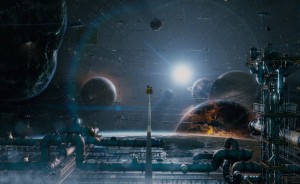
Digital effects were of course used in the film, but mainly for dramatic epic shots that could be done no other way. One of the most remarkable and complex CG pieces of the film is the Planet Factory Floor, where custom planets are assembled and it is one of the landmark effects sequences made by Cinesite in Europe. The Planet Factory scene was heavily pre-visualized in Cinema 4D, and Cinesite then took this and the building blocks from the Art department to build up the enormous sequence. The pipeline was based on animation and modeling in Maya, rendered into OpenEXR file formats and then composited in Shake, Inferno and Nuke. Nuke was choosen after almost a year in evaluation by Cinesite by the Planet Factory 2D lead Supervisor Christian Zeh, – He had played with Nuke and its 3D work space allowed for only the immediate foreground of several hundred miles to be full 3D, and the rest of the matte painting backgrounds to be Camera Projected matte paintings in the background.
The sequence was shot super 35, full grade, for a 2.35 release and back to 1.85 for DVD. The negative was scanned at 4k and then super sub-sampled down to 2K – which according to Cinesite means that when the film is up res-ed just prior to film output the over all result is almost as good as working full at 4K. The film was in post for 6 months but Cinesite was involved for over 18 months, from 2003 when the project was first bid. Sue Rowe started the project as Visual effects supervisor but left to have a baby and handed the pipeline to Adam McInnes to be visual effects supervisor for the remainder of the film.
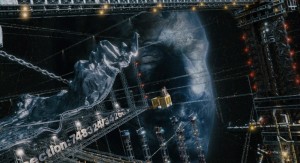
Cinesite included a great many in jokes themselves, for example one of the planets in the planet factory “the head planet” is actually Douglas Adams head. Adams head had been scanned for the computer game “Starship Titanic” in 1998.
comped in Inferno”]
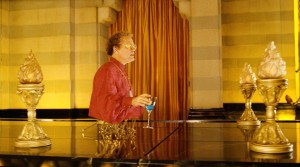
The computer scan was provided by Adam’s estate and not only used for the planet but also in a new world/environment not included in the book. Adam’s nose is used extensively in this world as door knobs, chairs and even as temple pillars of the new bad guy Humma Kavula – played by John Malkovich.
McInnes explains that Director Garth Jennings’ direction and back story on the character was that this ‘character’ was just an outside shell and “he was a hybrid being, inhabited by this tiny being”- but the external ‘body” had never been finished. So the character is “human” in appearance down to the waist and then just a series of legs and props. “Hence the legs trail a bit or bend,” says McInnes. “It’s not finished- it’s all down to the little quirks that make it seem real”. This was one of the main sequences composited in Inferno and not Shake or Nuke – due to the large amount of repair and clean up work on the table that the character moves across. The sequences involved complex multiple motion control passes. “We had a digital pipeline that involved basically pre-comps in Shake and then the final images are given to a guy in Inferno.”
For Shake, Cinesite has a “3D space node” similar to what was in Cineon, to help with 3D compositing…and of course their Inferno and Nuke workstations have full 3D workspaces. With regards to the main CG pipeline, Cinesite “like many places” says McInnes, “is trying to find ways of working with Renderman without having to write very very complex shaders. So we spilt everything out into spec passes, diffuse passes, shadow passes, etc which can then be combined in a more flexible way later on. We split the lighting up into several parts which can then be combined in a beauty maker – which is equivalent to what is done in a shader.” This gives the team flexibility to go back and adjust the render without re-rendering.
Cinesite also had to produce Zapod’s second head. This technique came from early tests Jennings did to actually be considered to direct the film. Cinesite’s Stuart Partridge used 2D techniques on a second pass shot on green screen to composite in Zapod’s second head. For shots that this wouldn’t work, the actors head was shot flat with 2 cameras and then projected onto 3D geometry, for shading and lighting. “We managed to get away with flopping one of the side cameras if we needed to do the other side of his head and get away with that,” says McInnes. He feels the technique worked well and all the natural skin texture was effective got for free, rather than having to model the face fully with sub-surface scattering in 3D.
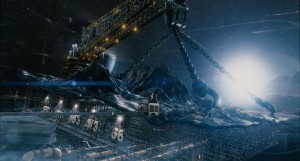 One technique that the team had expected to be able to use to save time that didn’t work was the jump cuts in the opening destruction of Earth. The theory was that for the infinite pull out from earth to outer space, the sequence would be done as a series of jump cuts avoiding the need for the whole sequence to be rendered as one shot. While it sounded great on paper it completely backfired for the Cinesite team. Not only did they end up having to actually render the whole sequence anyway to decide which frames to use for the cut and to avoid continuity jumps, but because the camera was no longer flying around but jumping in stages they could not use motion blur to hide the seams and blur the layers. Jan Toensmann, lead on the shot, used a traditional approach of a set of nested matte paintings with volumetric clouds projected on flat polygons. But without motion blur the shot was extremely unforgiving. Added to this problem, the model shoot of the Vogon ship was determined to not be close enough to the camera and thus fully replaced by a CG version. The shot took almost the entire period of film’s post on that one sequence, with up to 4 people at a time working on it. Even the explosion of earth, which was painstakingly modeled as a complex CG explosion and particle system over 30 or 40 frames, got compressed and cut to 6 frames. It ended up as a “classic comedy moment,” explains McInnes.” You build up to it and then nothing just a small puff” and its gone.
One technique that the team had expected to be able to use to save time that didn’t work was the jump cuts in the opening destruction of Earth. The theory was that for the infinite pull out from earth to outer space, the sequence would be done as a series of jump cuts avoiding the need for the whole sequence to be rendered as one shot. While it sounded great on paper it completely backfired for the Cinesite team. Not only did they end up having to actually render the whole sequence anyway to decide which frames to use for the cut and to avoid continuity jumps, but because the camera was no longer flying around but jumping in stages they could not use motion blur to hide the seams and blur the layers. Jan Toensmann, lead on the shot, used a traditional approach of a set of nested matte paintings with volumetric clouds projected on flat polygons. But without motion blur the shot was extremely unforgiving. Added to this problem, the model shoot of the Vogon ship was determined to not be close enough to the camera and thus fully replaced by a CG version. The shot took almost the entire period of film’s post on that one sequence, with up to 4 people at a time working on it. Even the explosion of earth, which was painstakingly modeled as a complex CG explosion and particle system over 30 or 40 frames, got compressed and cut to 6 frames. It ended up as a “classic comedy moment,” explains McInnes.” You build up to it and then nothing just a small puff” and its gone.
McInnes feels one of the great challenges that made the project so interesting for Cinesite was “to find a blend of believable effects that actually had comic elements. Very different from your normal Sc-Fi where you’re going for just those classic Sc-Fi shots. This was quirky and very different.”
All images Copyright Touchstone Pictures, All rights reserved.
